Barnaba da Modena on:
[Wikipedia]
[Google]
[Amazon]
 Barnaba da Modena (c. 1328-c.1386) was a mid-14th-century Italian painter who painted in the style of Byzantine art.Raimond Van Marle, ''The Development of the Italian Schools of Painting'', Springer Science & Business Media, 2012, p. 382-383 He is considered the first Lombard painter of note and was active in Lombardy,
Barnaba da Modena (c. 1328-c.1386) was a mid-14th-century Italian painter who painted in the style of Byzantine art.Raimond Van Marle, ''The Development of the Italian Schools of Painting'', Springer Science & Business Media, 2012, p. 382-383 He is considered the first Lombard painter of note and was active in Lombardy,
 Barnaba da Modena (c. 1328-c.1386) was a mid-14th-century Italian painter who painted in the style of Byzantine art.Raimond Van Marle, ''The Development of the Italian Schools of Painting'', Springer Science & Business Media, 2012, p. 382-383 He is considered the first Lombard painter of note and was active in Lombardy,
Barnaba da Modena (c. 1328-c.1386) was a mid-14th-century Italian painter who painted in the style of Byzantine art.Raimond Van Marle, ''The Development of the Italian Schools of Painting'', Springer Science & Business Media, 2012, p. 382-383 He is considered the first Lombard painter of note and was active in Lombardy, Piedmont
it, Piemontese
, population_note =
, population_blank1_title =
, population_blank1 =
, demographics_type1 =
, demographics1_footnotes =
, demographics1_title1 =
, demographics1_info1 =
, demographics1_title2 ...
, and Pisa
Pisa ( , or ) is a city and ''comune'' in Tuscany, central Italy, straddling the Arno just before it empties into the Ligurian Sea. It is the capital city of the Province of Pisa. Although Pisa is known worldwide for its leaning tower, the cit ...
in Tuscany.
Life
As his name indicates, the artist was a native ofModena
Modena (, , ; egl, label=Emilian language#Dialects, Modenese, Mòdna ; ett, Mutna; la, Mutina) is a city and ''comune'' (municipality) on the south side of the Po Valley, in the Province of Modena in the Emilia-Romagna region of northern I ...
(Emilia). The first records regarding Barnaba date to 1361 and 1362 when he had already become a Genoese citizen and was hiring Tuscan assistants.John Richards, "Barnaba da Modena." Grove Art Online. Oxford Art Online. Oxford University Press. Web. 17 March 2016 His earliest dated paintings relate to his activities in Genoa. He produced paintings for the Palazzo Ducale Several palaces are named Ducal Palace (Italian: ''Palazzo Ducale'' ) because it was the seat or residence of a duke.
Notable palaces with the name include:
France
* Palace of the Dukes of Burgundy, Dijon
* Palace of the Dukes of Lorraine, Nancy
* ...
in Genoa in 1364. His earliest known painting is a polyptych of the ''Virgin and Child with Saints'' ( Palazzo Bianco, Genoa), which combines the Gothic style of Tuscan polyptychs with Emilian design. Another work, a ''Virgin and Child'' (Museum of Fine Arts, Boston
The Museum of Fine Arts (often abbreviated as MFA Boston or MFA) is an art museum in Boston, Massachusetts. It is the 20th-largest art museum in the world, measured by public gallery area. It contains 8,161 paintings and more than 450,000 works ...
), shows the influence of Sienese painting in the rounded faces and the gold-striated highlights on Mary's mantle.
He was active in 1370 in Turin
Turin ( , Piedmontese language, Piedmontese: ; it, Torino ) is a city and an important business and cultural centre in Northern Italy. It is the capital city of Piedmont and of the Metropolitan City of Turin, and was the first Italian capital ...
. A painting (1377) by Barnaba was documented by Tiraboschi in the church of San Francesco in Alba
''Alba'' ( , ) is the Scottish Gaelic name for Scotland. It is also, in English language historiography, used to refer to the polity of Picts and Scottish people, Scots united in the ninth century as the Kingdom of Alba, until it developed i ...
.
Barnaba likely spent time in Pisa around 1380.
Work
Barnaba was a prolific artist who left about 50 works. He was successful in Genoa thanks to his adherence to the older style of Byzantine painting that was still very popular in the city. This explains his compositional schemes and the use of gold highlights and golden backgrounds, which are typical of Byzantine painting.Ingo F. Walther,Robert Suckale
Robert Suckale (30 October 1943 – 13 February 2020) was a German art historian, medievalist and professor at the Technical University of Berlin.
Life
Suckale was born in Königsberg. Suckale completed his studies in art history with the sub ...
, ''Masterpieces of Western Art: A History of Art in 900 Individual Studies from the Gothic to the Present Day'', Taschen, 2002, p. 47
An eclectic artist who did not follow the new trends that had developed in the 14th century, Barnaba was able to achieve a debt of feeling in his early works through his refined technique. Barnaba dominated painting in later 14th-century Genoa and possibly even in Pisa. His follower Nicolò da Voltri
Nicolò da Voltri was an Italian painter who was active in Genoa from 1394 to 1417. He was the most important native painter in Liguria, a coastal region of northwestern Italy. His early development took place, probably in the 1370s, in the cir ...
continued in his imagery and style in Liguria until c. 1420.
References
External links
{{DEFAULTSORT:Barnaba da Modena Trecento painters 14th-century Italian painters Italian male painters Painters from Lombardy Gothic painters Year of death unknown Year of birth unknown